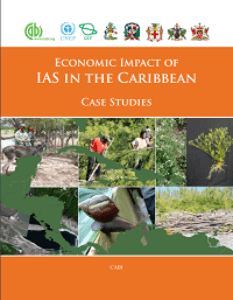Economic Impact of IAS in the Caribbean: Case Studies
Published: January, 2014
Book
To date no studies have been undertaken on the costs and benefits of IAS management in the Caribbean. This may partly explain why there has been negligible funding to combat the onslaught of these exotic species in the region. As a result it was decided to provide individuals involved in the UNEP-GEF Project, “Mitigating the Threats of Invasive Alien Species in the Insular Caribbean” with training and an opportunity to undertake Cost-Benefit Analyses (CBAs) on some selected IAS. The CBAs undertaken and reported in this publication clearly demonstrates that the benefits of managing IAS outweigh the costs.

Economic Impact of IAS in the Caribbean: Case Studies
Type Book
Published in Port of Spain, Trinidad and Tobago
Language English
Year 2014
Related projects
Researching introduced forest species in Trinidad
Many introduced species can have an adverse effect on native biodiversity, especially on a delicate island habitat such as Trinidad and Tobago. Three forest species are being particularly troubling, namely, Tectona grandis (teak), Acacia mangium (brown salwood) and Leucaena leucocephala (white leadtree). So, with funding from the FAO, CABI researched the species to find out how they behave and where they have invaded with a view to controlling them sustainably.
Start: 01/02/15 -End: 31/01/16
